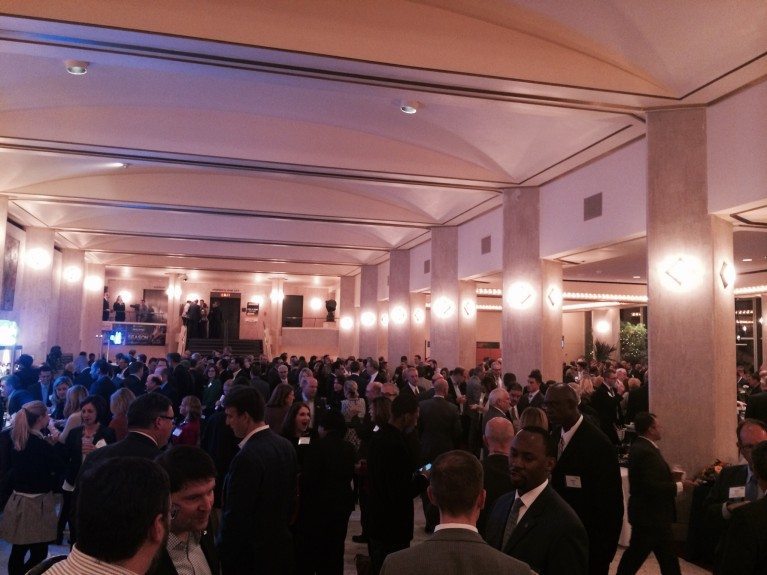If southeastern Wisconsin does not start investing in the health of its cultural and entertainment assets more intentionally, the region could stand to lose significantly in the battle for top talent, according to a task force of regional community leaders convened by the Metropolitan Milwaukee Association of Commerce.

The MMAC used the need to back key cultural and entertainment venues with more funding as a centerpiece for its All Member Meeting (click here to see a photo gallery from the event), held Monday evening at the Marcus Center for the Performing Arts.
The biennial meeting followed the release of a report developed by the 50-person task force, which was created to assess funding needs for major cultural and entertainment landmarks, including the Milwaukee Art Museum, Milwaukee Public Museum, the Marcus Center for the Performing Arts and the Milwaukee County Zoo.
The report points to the conclusion that more funds need to be allocated to the region’s cultural and entertainment hotspots in order to ensure their long-term vitality and appeal to the lifestyle of the Millennial workforce.
“Surveys show and shifting demographics confirm that young adults with portable talent – including our own children and grandchildren – increasingly are deciding first where they want to live and then where they’re going to work,” the report states. “And where they want to live depends largely on ‘quality of place’ – a term that has come to describe a blend of social and cultural amenities, openness to new ideas and people, and physical aesthetics. As a result, employers looking to recruit young professionals are creating jobs and fueling a virtuous cycle of economic growth in metro areas that rank high on these attributes.”
Milwaukee County-owned arts and cultural assets and parks will likely need at least $250 million to cover deferred maintenance and capital improvement over the next five years, according to the task force’s findings.
The challenge to raise those funds is compounded by the funding shortfall cultural and entertainment assets have experienced in the last decade and a half.
Since 2001, the distribution of tax dollars for county-owned cultural facilities has dropped by more than 40 percent in inflation-adjusted dollars, according to the task force’s report.
One way to boost public funding, according to the task force, would involve imposing a sales tax surcharge.
The task force projects that about $325 million could be collected through a five-year, one half center sales tax in Milwaukee County.
The MMAC’s All Member Meeting, which drew more than 1,000 of its members, underscored the need to ensure that southeastern Wisconsin is a place where, as Milwaukee Art Museum director Daniel Keegan said, people want to stay.
Keegan was part of a panel discussion of leaders from both the business community and the culture community that volleyed insight about why the region’s cultural and entertainment landmarks deserve more financial support.
“We must become a great destination, a thriving cultural center, a place where people want to live and work and play and ultimately stay,” Keegan said. “And that requires an amazing mix of opportunities, of destinations and of…assets that we call culture.”
Along with Keegan, the panel was comprised of Todd Teske, president and chief executive officer of Briggs & Stratton, Inc.; Deanna Tillisch, president and CEO of United Performing Arts Fund; and Robert Davis, president and CEO of the Zoological Society of Milwaukee.
Keegan, Tillisch and Davis all hit on the challenge of raising additional funds to cover gaps at their respective institutions.
For instance, while the Milwaukee Art Museum charges $17 for admission for visitors, it costs the museum $44 for each visitor who walks through its doors. And UPAF, which promotes the wellbeing of the region’s performing arts groups, does not accept public funds so that it does not have to compete for dollars against the organizations it supports.
To generate the private philanthropy and public funds needed by area cultural and entertainment sites, Tillisch believes a “cultural vision” is critical.
The region’s cultural and entertainment sector does not have “a shared voice” or the right channels through which to communicate the value of its assets, according to Tillisch.
Having a “cultural vision” for the region can give the sector a “compelling story” that the community can rally behind, she said.
Teske discussed the role top-tier cultural attractions play in swaying top-tier talent to live and work in Milwaukee at companies like Briggs & Stratton.
Business depends on talent, and really good workers are often very mobile, he said.
The region has some great assets and in order to clinch the kind of talent the region needs, “it’s really important to be able to take advantage of these assets and to sell ourselves,” Teske said.
“People want to have things to do,” he added, emphasizing that businesses must invest in cultural assets to keep workers in the region and continue growing their companies.
Moving forward, the MMAC will engage the community in order to determine a consensus about the best way to draw more funds into the region’s cultural and entertainment venues, according to Tim Sheehy, president of the MMAC.
Should a sales tax be determined the best method, a referendum would be sought, Sheehy said.


